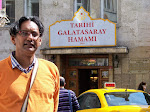The terms Taasegraphy derive from the French word tasse (cup), which in turn derives from the Arabic tassa (cup), and the Greek suffixes -graph, -logy, and -mancy (divination).
Scotland, Ireland, and England have produced a number of practitioners and authors on the subject, and English potteries have crafted many beautiful tea cup sets specially designed and decorated to aid in fortune-telling. Cultures of the Middle East that practice divination in this fashion usually use left-over coffee grounds from Turkish coffee turned over onto a plate.
Method of tea-leaf reading:
The Encyclopedia of Occultism & Parapsychology, Fifth Edition, Vol. 2 edited by J. Gordon Melton, notes:
After a cup of tea has been poured, without using a tea strainer, the tea is drunk or poured away. The cup should then be shaken well and any remaining liquid drained off in the saucer. The diviner now looks at the pattern of tea leaves in the cup and allows the imagination to play around the shapes suggested by them. They might look like a letter, a heart shape, or a ring. These shapes are then interpreted intuitively or by means of a fairly standard system of symbolism, such as: snake (enmity or falsehood), spade (good fortune through industry), mountain (journey of hindrance), or house (change, success).
Melton's described methods of pouring away the tea and shaking the cup are rarely seen; most readers ask the querent to drink the tea off, then swirl the cup. Likewise, his notion that readers give intuitive interpretations reflects his unfamiliarity with teacup reading; most readers use the standard symbols that have been handed down through several generations. There are, however, many who prefer to read by feel and intuition, as stated by Melton.
It is traditional to read a cup from the present to the future by starting along the rim at the handle of the cup and following the symbols downward in a spiral manner, until the bottom is reached, which symbolizes the far future. Most readers see images only in the dark tea leaves against a white or neutral background; some will also read the reverse images formed by seeing the symbols that form in the white negative spaces, with a clump of dark leaves forming the background.
Some people consider it ill-advised for one to attempt tasseography using tea from a cut-open tea bag or to use a symbol dictionary. The reasons for these prohibitions are practical: tea-bag tea is cut too finely to form recognizable figures in the cup and tea-leaf reading has its own historic system of symbolism that does not correspond exacty with other systems, such as symbolic dream divination.






No comments:
Post a Comment